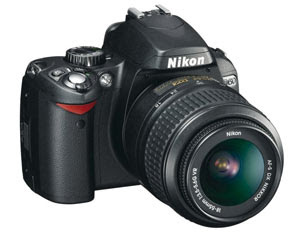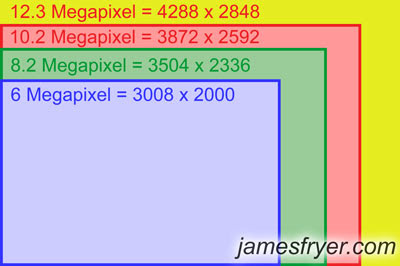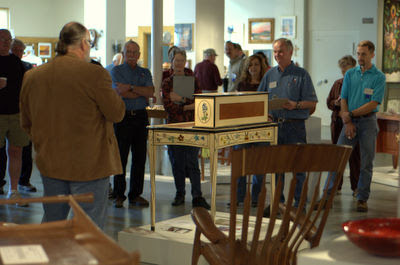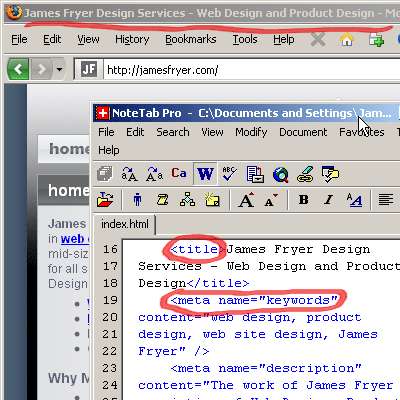Need help deciding between a Nikon D40 and Nikon D60
and Nikon D60 ? This article is my effort to make that decision easier by comparing the two.
? This article is my effort to make that decision easier by comparing the two.
 Here is the really brief recommendations. If you are a novice shooter on a budget, get the D40
Here is the really brief recommendations. If you are a novice shooter on a budget, get the D40 . If you are a novice shooter who wants to splurge a bit, get the D60
. If you are a novice shooter who wants to splurge a bit, get the D60 . If you know something about photography already and want to get to know your camera and play with settings and maybe get a few lenses, get the D40. Why should a more advanced shooter get the D40? so you can take the money you saved by getting the D40 and put it towards software, a lens, or a flash. These things will make a bigger difference to your photography than the D60 will.
. If you know something about photography already and want to get to know your camera and play with settings and maybe get a few lenses, get the D40. Why should a more advanced shooter get the D40? so you can take the money you saved by getting the D40 and put it towards software, a lens, or a flash. These things will make a bigger difference to your photography than the D60 will.
Disclosure: I do not own either of these cameras, though I have handled both and shot with a D40X. The D40X has been replaced by the D60 and can be thought of as being right in between the D40 and the D60. I own a D70 and have, to date, shot about 53,000 pictures with it. I am a semi-professional photographer in that people have paid me to take pictures and I have sold 'art' photographs as well. But I do not make a living from photography, I am primarily a designer. Though I have enough technical knowledge to shoot reasonably good 'product photography' (and have been paid to do that), I approach photography from an artistic rather then technical background and perspective.
The Body
What is the same between the D40 and the D60? They use the same camera body. This is a small camera body by DLSR standards, but has a very comfortable grip and is easy to hang onto. Because they have the same body, they both lack an auto focus motor. This means that they only auto focus with the newest (and most expensive) lenses. This is not as bad as it sounds, if you buy the camera with a lens (this is called the kit lens), that lens will have a motor built into it so it will be able to auto focus. If you plan on only using the kit lens (or lenses), you will have no problem.
If, however, you will want to buy more lenses, you will have to be careful to buy AF-S lenses as these are (practically) the only lenses that will auto focus on the D40 and D60. AF and AF-D lenses will not auto focus, but they will mount and the light meter will work. AI lenses will also mount, but will not auto focus nor will the light meter work. If you don't mind, or actually plan on manually focusing, then you have no problem. In fact, 90% of my pictures are manually focused, so I could almost as easily use a D40 as I do my D70. Where the D40 would become a problem for me is when I am shooting people with my Nikon 24mm AF lens. That is the lens I most like to shoot with at events and I always have it on auto focus. A good portion of the rest of the shots I take are 'macro' shots where auto focus does not really work anyway. If your primary purpose is macro photography, then both the D40 and D60 would serve you just as well as the D50, D70, or D80. Ken Rockwell has a great chart that shows lens compatibility.
As mentioned, this is a small body but I have seen big guys (6'4") and little gals (5'2") both handle it very comfortably. Nikon definitely has the ergonomics of this body perfected.
DOF Preview
The other feature that both these cameras lack is a DOF preview button. DOF stands for Depth Of Field. This refers to what parts of the image will be in focus. A shallow DOF means that only a little of the image will be in focus, everything else will be blurry. A deep DOF means a lot of the image will be in focus, or at least closer to being in focus. Below, the image on the left has a shallow DOF, the image on the right has deep DOF. Note the tree trunk is in focus in both pictures, but the window is much blurrier on the left.
 When you have a DOF preview button, you can get a better sense of what will be in focus and what won't. But it's not a huge feature and most people will not miss it.
When you have a DOF preview button, you can get a better sense of what will be in focus and what won't. But it's not a huge feature and most people will not miss it.
The Sensor
The sensor is pretty much the same on the D40 and the D60, they both use CCD (as does my D70). The D60 has a 10MP sensor where as the D40 has a 6MP.
If it is fair for me to extrapolate my experience with testing the D70 and D80 to the difference between 6 and 10 mega pixels of the D40 and D60, then I can say it makes very little difference. Granted, you could push the 10MP to a print size of 24x36" over the 6MP's 20x30" print size, but the added grain of the 10mp will be noticeable. So much so, that you may not want to print that big.
to the difference between 6 and 10 mega pixels of the D40 and D60, then I can say it makes very little difference. Granted, you could push the 10MP to a print size of 24x36" over the 6MP's 20x30" print size, but the added grain of the 10mp will be noticeable. So much so, that you may not want to print that big.
How often will you want to print 24x36"? If you want that at all, then yes, you are better off with the D60. But look at the graphic below to get a good sense of the real difference between the mega pixel sizes.
 Where you really get nailed is the file size. A 2gig card will hold 360 6mp RAW files. The same card holds only 190 10mp files. The larger files are slower to work with and clog up a hard drive faster.
Where you really get nailed is the file size. A 2gig card will hold 360 6mp RAW files. The same card holds only 190 10mp files. The larger files are slower to work with and clog up a hard drive faster.
JPG vs RAW
Let's take a moment to look at JPG vs RAW. The D40 and the D60 can both capture pictures in both JPG and RAW. When you take a picture with any digital camera the initial information that is generated is what we call the RAW file. Almost all point and shoot digital cameras then take the RAW file and process it into a JPG file. The JPG file takes up less space in your camera and computer and it is a very common format so it is easier to share with people or to print out at a photo center. Also, when the camera converts the image to JPG, it applies a number of 'effects' to make the image look better like increasing the color saturation, sharpening the image, applying 'white balance' so the colors look more natural, etc. The JPG gives you a great finished product that can be used for many purposes.
All DSLRs and a few point and shoots give you the option to save that RAW file. The RAW file has more image data in it and is better suited for 'post processing'. Post processing is when you take the picture onto your computer and use software to make adjustments to it. It is like developing a negative. The down side is that the files take up much more space and they will not look as good as a JPG until you 'develop' them on the computer. It is also not at all practical to try and share these images with anyone else unless you convert them to JPG.
So when should you use RAW? If you know you want to do a lot of post processing and get every last ounce of quality in an image, use RAW. I use RAW when I shoot my 'art' photography. When I shoot events, people, or my family, I always switch to JPG because it is much easier to handle and the image degradation is so minor in these shots that it won't show up when viewing the pictures on a computer or even with moderate sized prints of 12x18". In fact, I could still blow a JPG image up to 20x30" and only professionals would be able to really see the difference between RAW and JPG.
So don't worry about it, shoot JPG unless you have a specific reason to shoot RAW.
The D60 has Nikon's new Expeed image processor. This is similar to what is used in the much more expensive D300 , D700
, D700 , and D3
, and D3 . It will probably create slightly nicer JPG images out of the box. But if you are willing to dive into the camera's menus, you will be able to create great results with either the D40 or the D60. If you want to pull the camera out of the box and just start shooting, get the D60.
. It will probably create slightly nicer JPG images out of the box. But if you are willing to dive into the camera's menus, you will be able to create great results with either the D40 or the D60. If you want to pull the camera out of the box and just start shooting, get the D60.
Dust Reduction System
Another advantage the D60 has over the D40 is a dust reduction system that helps keep the sensor clean and your images spot free. If you change lenses a lot, this might be a useful feature as it is when you change a lens that you are most likely to get dust into the camera that might eventually find its way onto your sensor. If you don't change lenses much, it is unlikely that much, if any, dust will fall on the sensor. But if you want to keep your sensor super clean, you will want to swab the sensor clean occasionally. Because I swap lenses a lot (frequently outside) I clean my sensor with VisibleDust swabs and solution every few months. Most people won't need to do it that often or at all.
For people like me who have to clean the sensor anyway, this feature is not very useful. But, it is still a good feature and another thing that sets the D60 apart from and above the D40.
Flash Sync Speed
Here is one that goes into the D40's column, it has a much faster flash sync speed then the D60, 1/500th of second as opposed to the D60 1/200th of a second. This I just don't get, why does the 'better' camera have a much slower (and therefore, worse) sync speed? The sync speed is how fast your camera can shoot when using the flash. So the D40 can have an exposure time of 1/500ths of a second when shooting with the flash, but the D60 shoots more then twice as slow. A fast sync speed is helpful if you are trying to catch fast motion and freeze it without any blurring. Not something most people do a lot of. So, unless you already knew what flash sync speed was, you probably won't mind that the D60 is slower.
Active D-Lighting
Active D-Lighting is another new feature of the D60 not found in the D40. When active, it essentially lightens the dark areas of the image so that detail is not lost in areas of shadow. It is a mild effect and one that takes extra time for the camera to apply so it slows the camera down. For this reason, it is best to use the feature sparingly. This same effect can be achieved in post processing with programs like Lightroom , Photoshop
, Photoshop , Aperture, or even free programs like Picasa or Raw Therapee.
, Aperture, or even free programs like Picasa or Raw Therapee.
Also, the use of 'fill flash' (with either the D4o or D60) will do a better job of lightening dark areas of the image, but only for smaller scenes. Fill flash is only as powerful as the flash that is used and no flash will be powerful enough to work on a large scene like a landscape. Fill flash is the technique of using a flash on a bright day to overcome the a bright background. For instance, if you are shooting a portrait of someone against a bright sky, the person's face will be too dark because the camera is exposing for the bright sky. If you use a flash, then the person's face will be lit properly.
Active D-Lighting is yet again another very minor benefit and one that is of no use to an advanced photographer who will be post processing anyway. But, for the novice who does not want to mess about in post processing, this is a nice feature of the D60.
VR
Now we get to the main event. VR stands for Vibration Reduction. This is a technology that Nikon (and Canon) build into their lenses to counteract camera shake to help you create sharper pictures. If the shutter speed is too slow, the image will be blurry because we can not hold our cameras still enough (unless it's on a tripod). VR smooths out our jittery nature to make sharper images. The D60's 'kit' lens has VR, the D40's 'kit' lens does not, though the D40 is compatible with VR lenses.
VR only works when you are taking pictures of still objects, it won't slow down that three year old tearing across the living room. If you are shooting a group of people who are old enough to sit still for a second, or a flower that is not being blown around in the wind, then VR can definitely help.
Other manufactures have similar technology, but they build it into the camera instead of the lenses. Lens based VR systems (known as IS - Image Stabilization - on other brands) tend to outperform camera based systems. The down side the the lens based system is the you have to pay for the technology with every lens that you buy.
For my money, VR is only significant difference between the two cameras. I have not used VR lenses much with my D70, but that's just because of the type of shooting I do. I have it on my little Canon point and shoot A720 IS and it is great, I use it all the time on that. The majority of people will find VR useful and it is the most compelling thing the D60 has going for it over the D40. But, still, I don't see it as a definite 'must have'. And that is the thing with the D60, there is no one feature that puts is over the top. Unlike the D80, if you want to use older AF lenses, the D80 has a killer advantage over the D40 and D60 because the D80 will auto focus those old lenses.
Currently (summer 2008), the D60 is $160 more then the D40
is $160 more then the D40 (the prices fluctuate from day to day, but this is the average). That $160 dollars can nearly buy a Nikon SB-600 Speedlight
(the prices fluctuate from day to day, but this is the average). That $160 dollars can nearly buy a Nikon SB-600 Speedlight that will make more of a difference than all these little upgrades the D60 offers. Including offsetting the advantage of the VR lens, you don't need VR if you have a good, powerful flash. This is especially true if you are shooting people inside or in other low light situations.
that will make more of a difference than all these little upgrades the D60 offers. Including offsetting the advantage of the VR lens, you don't need VR if you have a good, powerful flash. This is especially true if you are shooting people inside or in other low light situations.
In the end, it is a close call. If you are on a budget, or plan to get a more powerful flash, go with the D40. The D60 does have enough small improvements to warrant consideration, especially if you are not strapped for cash. I think the D60 will also serve the novice user better than the D40. All those little upgrades make is a little easier to take good pictures with the D60.
But in the end, if you want a camera to just take snap shots of your kids, a smaller and cheaper point and shoot camera like the Canon SD850 IS will be much easier to carry around and shoot with. I have a Canon A720IS
will be much easier to carry around and shoot with. I have a Canon A720IS for times like that.
for times like that.
 This state wide show is a growing phenomenon open to all Texas furniture makers. Because of the large pool of interested furniture makers, work will be selected for the show by a jury. Work accepted for the show will be eligible for the following list of prizes:
This state wide show is a growing phenomenon open to all Texas furniture makers. Because of the large pool of interested furniture makers, work will be selected for the show by a jury. Work accepted for the show will be eligible for the following list of prizes:




